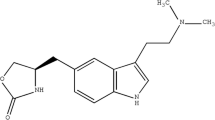Abstract
The in vivo assessment of percutaneous absorption of molecules is a very important step in the evaluation of any transdermal drug delivery system and a key goal in the design and optimization of transdermal dosage forms lies in understanding the factors that determine a good in vivo performance. The objective of the present investigation is to assess the in vivo performance of an optimized transdermal system of ondansetron hydrochloride in rabbits and to generate preclinical pharmacokinetic data. The pharmacokinetic performance of ondansetron hydrochloride following intravenous and transdermal administration was studied in rabbits following non compartmental pharmacokinetic analysis. The pharmacokinetic parameters such as area under the curve, elimination rate constant, elimination half life and mean residence time, were significantly (P < 0.01) different following transdermal administration compared to intravenous administration. Absolute bioavailability of the transdermal film studied was estimated to be 0.37 ± 0.06 which is quite low because a very high drug loading in the transdermal system was essential to achieve sufficient thermodynamic activity for transdermal permeation. Though in vivo studies in rabbits are found promising, investigations in healthy human subjects are essential to confirm the performance of the developed transdermal films.



Similar content being viewed by others
References
Chien YW, Chien TY, Bagdon RE, Huang YC, Bierman RH (1989) Transdermal dual-controlled delivery of contraceptive drugs: formulation development, in vitro and in vivo evaluations, and clinical performance. Pharm Res 6:1000–1010
Emami J (2006) In vitro-in vivo correlation: from theory to applications. J Pharm Pharmaceut Sci 9:31–51
Godin B, Touitou E (2007) Transdermal skin delivery: predictions for humans from in vivo, ex vivo and animal models. Adv Drug Deliv Rev 59:1152–1161
Guy RH, Hadgraft J, Hinz RS, Roskos KV, Bucks DAW (1987) In vivo evaluations of transdermal drug delivery. In: Chien YW (ed) Transdermal controlled systemic medications. Marcel Dekker, New York, pp 179–224
Keshary PR, Chien YW (1984) Mechanism of transdermal controlled nitroglycerin administration. Part 2. Assessment of rate controlling steps. Drug Dev Ind Pharm 10:1663–1699
Kim MK, Zhao H, Lee CH, Kim DD (2001) Formulation of a reservoir-type testosterone transdermal delivery system. Int J Pharm 219:51–59
Krishnaiah YSR, Rama B, Raghumurthy V, Ramanamurthy KV, Satyanarayana V (2009) Effect of PEG6000 on the in vitro and in vivo transdermal permeation of ondansetron hydrochloride from EVA1802 membranes. Pharm Dev Technol 14:50–61
Rao PR, Diwan PV (1999) Comparative in vivo evaluation of diltiazem hydrochloride following oral and transdermal administration in rabbits. Indian J Pharmacol 31:294–298
Rao PR, Reddy NM, Ramakrisna S, Diwan PV (2003) Comparative in vivo evaluation of propranolol hydrochloride after oral and transdermal administration in rabbits. Eur J Pharm Biopharm 56:81–85
Schmook FP, Meingassner JG, Billich A (2001) Comparison of human skin or epidermis models with human and animal skin in in vitro percutaneous absorption. Int J Pharm 215:51–56
Swain K, Pattnaik S, Sahu SC, Mallick S (2009) Feasibility assessment of ondansetron hydrochloride transdermal systems: physicochemical characterization and in vitro permeation studies. Lat Am J Pharm 28:706–714
Swain K, Pattnaik S, Sahu SC, Patnaik KK, Mallick S (2010) Drug in adhesive type transdermal matrix systems of ondansetron hydrochloride: optimization of permeation pattern using response surface methodology. J Drug Target 18:106–114
Author information
Authors and Affiliations
Corresponding author
Rights and permissions
About this article
Cite this article
Swain, K., Pattnaik, S., Yeasmin, N. et al. Preclinical evaluation of drug in adhesive type ondansetron loaded transdermal therapeutic systems. Eur J Drug Metab Pharmacokinet 36, 237–241 (2011). https://doi.org/10.1007/s13318-011-0053-x
Received:
Accepted:
Published:
Issue Date:
DOI: https://doi.org/10.1007/s13318-011-0053-x




